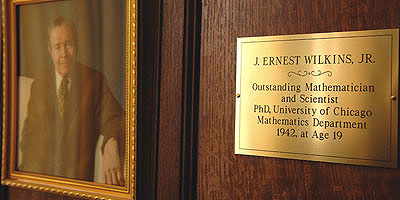Mathematician, alumnus Wilkins honored for inspirational, scientific achievements
By Steve KoppesNews Office
 Members of the University community recently honored alumnus J. Ernest Wilkins Jr. (above) at a reception, where Dean Robert Fefferman, Deputy Provost Kenneth Warren, the Fairfax M. Cone Distinguished Service Professor in English Language & Literature and the College, and University Trustee Walter Massey spoke about Wilkins’ accomplishments as a mathematician and scientist. Wilkins completed his Ph.D. at Chicago in Mathematics in 1942 at age 19.  | |
On a recent snowy March afternoon in the Eckhart Hall Tea Room, J. Ernest Wilkins Jr. officially took his place among the University’s pantheon of legendary scientists and mathematicians. Wilkins’ portrait and a plaque in his honor were officially unveiled at a reception on Friday, March 2.
“Growing up reading about your achievements was an inspiration,” University Trustee Walter Massey told Wilkins at the ceremony. Wilkins’ diverse body of work means that researchers in multiple fields can lay claim to it, added Massey, a physicist and the president of Morehouse College in Atlanta.
Wilkins enrolled at the University at the age of 13 in 1936. At age 17, he received his A.B. in mathematics and ranked in the top 10 in the Putnam Competition, a national undergraduate mathematics contest. Wilkins remained at the University for graduate study in mathematics, receiving his Ph.D. as a 19-year-old in 1942.
“The University of Chicago Mathematics Department has extremely high standards. It’s been an outstanding department for quite some time,” said Robert Fefferman, Dean of the Physical Sciences Division and the Max Mason Distinguished Service Professor in Mathematics and the College. “It’s extraordinary for someone 19 years old to get a Ph.D. from a department of that quality in a very rigorous subject.”
Wilkins, 83, was born in Chicago to J. Ernest Wilkins Sr., a lawyer who served as U.S. Assistant Secretary of Labor from 1954 to 1958, and Lucile Robinson Wilkins, a teacher. Among his many achievements, the younger Wilkins in 1976 became the second African American to be elected to the National Academy of Engineering, one of the highest honors an engineer can receive.
Early in his career, Wilkins worked at Chicago on the Manhattan Project, the U.S. effort to build the atomic bomb. While here, he worked with future Nobel laureate Eugene Wigner and made contributions to nuclear-reactor physics, including what is now known as the Wilkins effect and the Wigner-Wilkins spectrum.
Wilkins also attained distinction in the private sector. Following the Manhattan Project, he worked as a mathematician for the American Optical Company in Buffalo, N.Y., designing lenses for microscopes and ophthalmologic uses. He held a variety of positions at the United Nuclear Corporation from 1950 to 1960. As manager of United Nuclear’s Research and Development Division, Wilkins oversaw a staff of approximately 30 scientists who did contract work for the Atomic Energy Commission.
During this time, he entered New York University to obtain formal training as a mechanical engineer. There he earned a B.S., with magna cum laude honors, in 1957 and another master’s degree in 1960. For the next 10 years, he managed additional nuclear-reactor projects for the General Atomic Company in San Diego.
He took a sabbatical leave in 1976 to become a visiting scientist at Argonne National Laboratory. From there, he became a vice president at EG and G Idaho Inc., in Idaho. Wilkins returned to Argonne as a Distinguished Fellow in 1984.
At various stages of his career, Wilkins taught at the Tuskegee Institute in Alabama, Howard University in Washington, D.C., and Clark Atlanta University in Georgia.
“He is such a fabulous role model that his example should encourage brilliant African-American mathematics and science faculty members and students to choose Chicago as their academic home,” Fefferman said.
The history of the physical sciences at the University is rife with significant contributions from individuals of widely diverse backgrounds. Just two examples include Alberto Calderón of Argentina and theoretical astrophysicist Subrahmanyan Chandrasekhar of India. They were two of the most influential thinkers in their fields during the 20th century, Fefferman said.
Without such people, “this would be a very different university in math and science,” Fefferman said.
“We would probably be lucky to be in the top hundred science universities in the United States, maybe even in the top 200. It’s just so absurd not to welcome everyone who wants to participate in what I consider a very compelling and noble adventure, discovering great science.”
![[Chronicle]](/images/sidebar_header_oct06.gif)